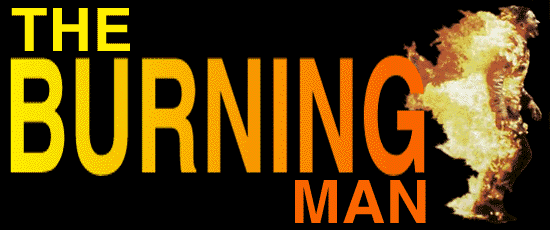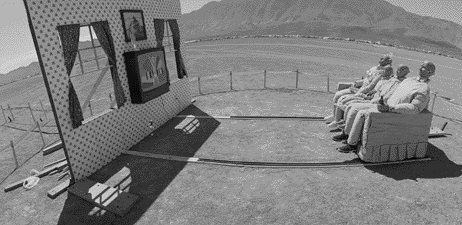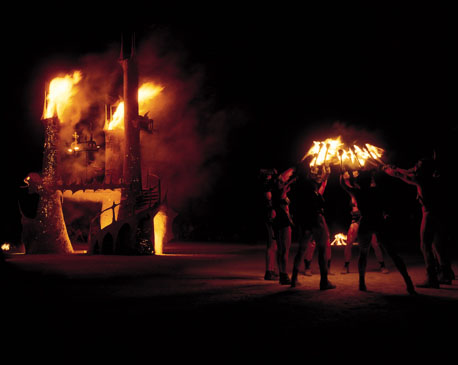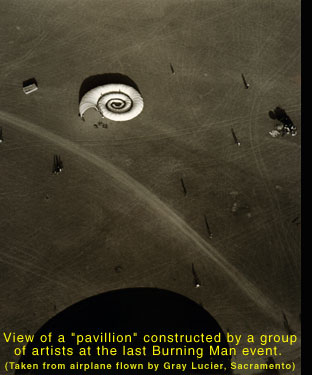
There is something about humans that has always drawn us together in times of emotional extremes. War dances or primitive religious ceremonies are not as common these days as tailgate parties or sports events, but the same emotionally charged energy exists in these cultural gatherings. In the 1960's it was music. Woodstock and similar gatherings defined the culture and served as a reminder that however odd the "freaks" of the time, they were not alone.
In the past decade there have been few dramatic gatherings like Woodstock. The "me too" generation, at times, seemed too self-centered to have any need for collective reassurance of their culture. Clothes and material possessions became the icons of success and worth. Competition, rather than cooperation, was rampant. But in the same part of America that spawned the Haight-Ashbury counter-culture of the "hippies," yet another type of collective expression has been born. Behold The Burning Man!
The celebration of Burning Man's annual fire ceremony began in 1986— created by San Francisco artists, Larry Harvey and Jerry James. For the next 5 years, its annual fire party was held at Baker's Beach in San Francisco. In 1990, while being prepared at Baker's Beach, the Park police interceded to prevent the culminating conflagration of the statue of a wooden man (and hence the name of the event). This was a transitional moment for Burning Man as the event evolved with a new location, a change of date, and the beginning of a new meaning for the celebration.
BURNING MAN: FROM BEACH TO DESERT
After the wood was cut, a handful of organizers shouted instructions, and soon the wooden figure of a man, complete with arms and legs, was being hammered together. The final connection was a rope tied to its chest. The completed statue was fabricated lying on its back. Organizers soon shouted for the gathered assistants to take their position in front of it, picking up the rope and hoisting the statue into its final vertical position.
Burning Man stood upright, rising 40 feet into the sky. He (or "it") was an incredible vista. The statue stood there in its clumsy form, surrounded by asphalt, concrete, brick, modern steel, and glass— facades of our society. Its pagan-like appearance made it look like it belonged to another era.
Larry Harvey and Jerry James, the creators and organizers of Burning Man, were very busy directing its construction. This was now the fifth reincarnation of the Burning Man.
The Burning Man was constructed solidly, but it was designed to be a temporary wooden icon. After admiring the structure, it was dismantled and carried to near-by Baker's Beach, where it was again admired in preparation for its burning in the annual ritual which had actually been instituted in 1986.
Golden Gate Park (GGNRA) Police had other plans. Because of
the potential fire hazard, they had decided to prohibit the burning of this wooden figure. The gathering crowd was disappointed, but enthusiastic. Organizer Larry Harvey suddenly realized that this small phenomenon had suddenly attracted the attention of thousands of spectators who viewed the spectacle as something personal and ritualistic. It was obvious that the "burning" was an essential part of the event which would now have to move outside of the metropolitan area. The 40 foot effigy was later lowered and dismantled, and the pieces were brought back to the parking lot and put in storage.

DISASTER OR DESTINY?
Parking lot attendants came upon the Burning Man parts and, not knowing what they were, took a chain saw to them, cutting them
up into scraps. Larry, devastated by the accidental mishap, was nevertheless challenged to make the event happen. Another work team and new materials created a new statue, and the quest for a ritualistic site ensued.
Several Cacophonists had proposed the Black Rock desert, in Northern Nevada, as an ideal alternate site. After investigating other potential sites, Larry accepted on faith that the Black Rock just might be the place for the wooden statue's intended celebration. He then rented a truck to transport the Man and decided that Labor Day weekend would be a perfect time to go into the desert.
LEAVING SAN FRANCISCO
On the day of departure, there were about 80 - 100 attendees, most of which had gathered at Golden Gate Park. As people showed up,
they brought all manner of luggage including back packs, suit cases, duffel bags, ice coolers, camping gear, hat boxes, and clothing bags. Most of this was piled in front of a Ryder truck. One woman only
brought her massage table, no food, no extra clothing or water. Many people were hitching rides in already filled cars, so the truck would not only bring out The "Man, "but also luggage that could
not be transported in other cars. There was a feeling of excitement and togetherness, reminiscent of the Haight Ashbury days and the cult following of bands like The Grateful Dead.
The Black Rock was a dried lake bed, encircled by a mountain range, sitting undisturbed for the last 30,000 years. The flat beach head of dried mud continued for hundreds of miles. For the Labor Day weekend, it would be the home to thousands of urbanites, unaccustomed to the primitive and expansive environment. The Cacophony were used to such trips. In fact, they had a name for them: "Zone Trips."
ENTERING THE ZONE
Just after dawn, the entourage arrived in the town of Gerloch (population 250), literally the last town before the desert. Having had breakfast at Bruno's cafe, (the only cafe in the town), the group re-formed and caravaned out onto the road leading to the desert. About six or seven miles later, they left the road, driving directly onto the desert, and stopped about 100 feet in. As far the eye could see, it was flat, flat, flat. Some of the group pitched their tents and began to settle in. The camp quickly became a community.
The alignment of the Burning Man in the desert was a solar configuration, as he was positioned in a place where the morning sun peeked above the horizon. Dawn worshippers could easily watch as the sun rose and passed through the statue, illuminating in turn each of his Chakra points. Eventually pausing, as if to cast a beatific halo around "Man's" head, the Sun, again, continued on its daily arc to mark the day.
The desert held all kinds of natural wonders, such as hot springs
and dust devils (circular columns of dust that dance across the desert
floor). There were moments of tremendous silence (especially appreciated from urban dwellers), and others where breezes turned, with sudden ferocity, into blinding white-out wind storms— some clocked as fast as 50 mph.
While the physical center of camp could have been called the town square, its spiritual center was the wooden statue. Burning Man was separated from the camp, creating a pilgrimage for people to leave camp to visit him.
The final moment had arrived, as the countdown closed in on Burning Man's rendezvous with the final fire, fellow Cacophonist and former carnival performer, David "Flameo" Warren, had the honor. Stepping up to the Man with a torch, he ignited his breath and a huge tongue of fire leapt forwards from his mouth bathing the Man's wooden legs.
It became a form of the Man holding "court" as people came to pay tribute to the Man. Some brought bad memories to sacrifice, others were drawn, as moths to flame, to watch the conflagration. And for others yet, it became their new year, as the fire bright cleaned out the old and created a spiritual space for a new year's growth. The evening that the Man was burned marked an ending and a new beginning.
The flame clung to the Man and began to climb upwards, engulfing his legs, then torso, quickly reaching to engulf the entire statue. It became a spectacle of enormous magnitude, the flaming statue illuminating the surrounding area, reveling the awe struck and cheering crowd who watched as the statue quickly lived up to its name. As the statue was consumed by flames, the campers gathered round in celebration with a formal cocktail party. Every one was dressed in party finery, women in their elegant gowns, men in tuxedos, others in bizarre costumes. Drinks were hosted, people were toasted— there was joy in the air.
The next morning, the group gathered around the blackened remains of Burning Man. He was nothing but charred wood and ash, but the event had triggered something in each participant that would make this annual event grow into an oasis of hedonistic ritual in the subsequent years.

One of the many "theme displays" at Burning Man. Recent celebrations of The Burning Man have included themes and what might be called "side shows" of art and expression. Creative displays and architectural structures added to the visual stimuli. Freedom of expression culminated in nude dancing, impromptu chanting and a host of pagan-like rituals. As one annual celebrant noted, "I used to go for the spiritual angle... now, I must confess, I am mainly attracted to the party atmosphere!" The last event, in 1998, had over 15,000 party-goers.
Next year's Burning Man will likely be the best, as publicity and word of mouth draw more urbanites to the otherwise desolate area for a celebration of life and the light of this burning effigy. 
|
 Burning Man (Photos by
Burning Man (Photos by 